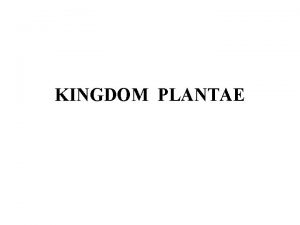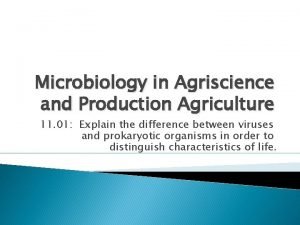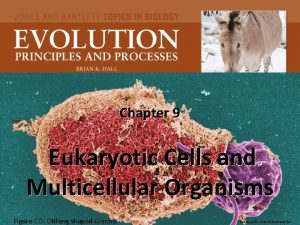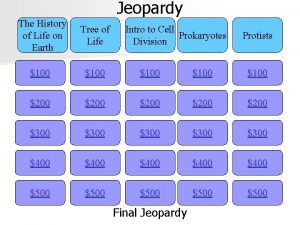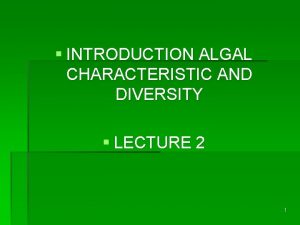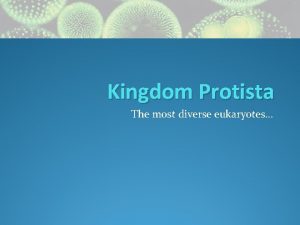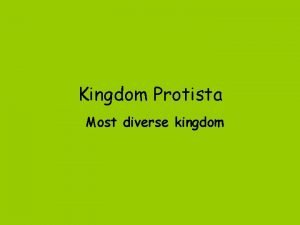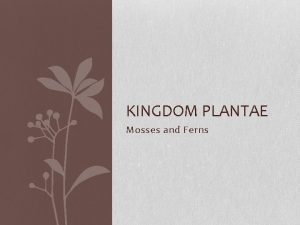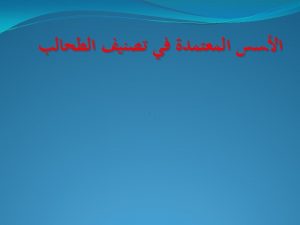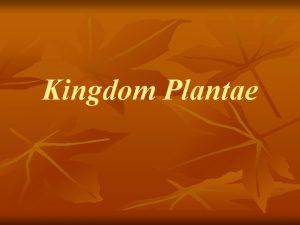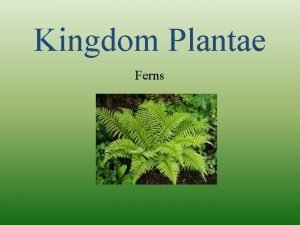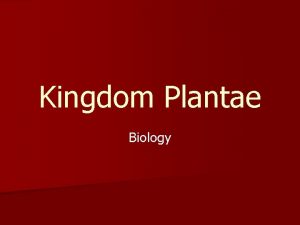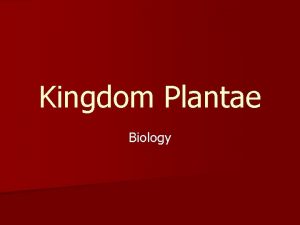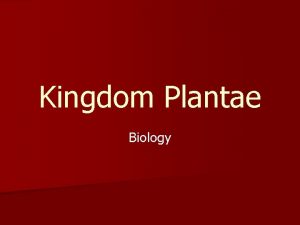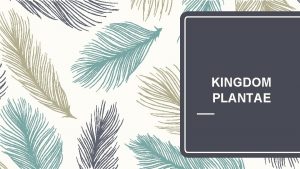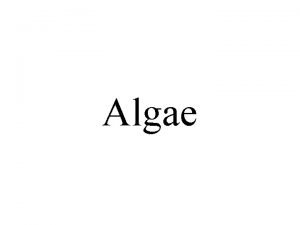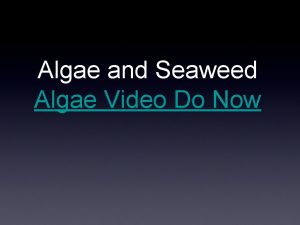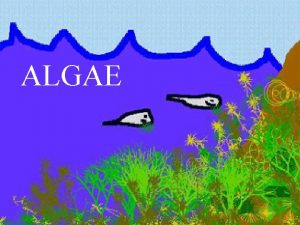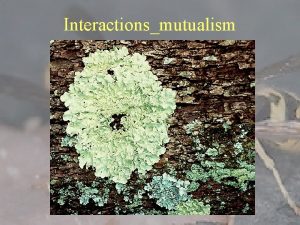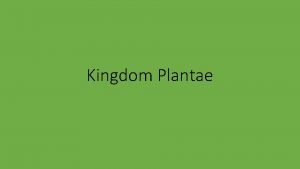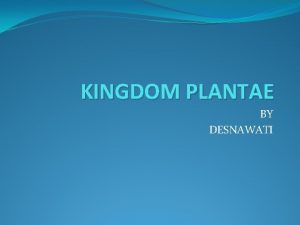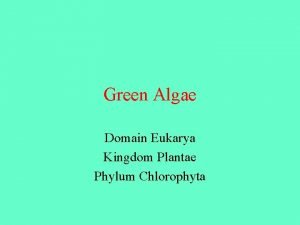KINGDOM PLANTAE CLASSIFICATION CLASSIFICATION ALGAE An eukaryotic cell
























- Slides: 24

KINGDOM PLANTAE

CLASSIFICATION

CLASSIFICATION

ALGAE • An eukaryotic cell organisation. • It is composed of pure or mixed carbohydrates (Cellulose, mucilage, pectin etc. ) and substances like alginic acid, fucoidin, fucin and hemicellulose are present in brown algae, pectin in red algae, silica in diatoms. • A true cell wall is, however absent in some algae like Euglena, Gymnodium and Pyramimonas. They have pellicele. • Algal cells are covered by mucilage which protect them from desiccation and epiphytic growth and decaying effect of water.

• Motile vegetative or reproductive cells are found in all groups of algae, except cyanophyceae and rhodophyceae. • The number of flagella varies from one to four. • Whiplash or acronematic flagella : Such flagella have a smooth surface. • Tinsel or pleuronematic flagella : The surface of these flagella is covered with fine filamentous appendages, known as mastigonemes or flimmers. • In uninucleate algae the nucleus generally lies alongside the cell wall but sometimes it is suspended in the center of the cell by fine cytoplasmic threads. In multinucleate members the nuclei usually occur between the vacuoles and plastids in the cytoplasm.


CHLOROPHYCEAE • • • HABITAT Green algae are cosmopolitan in distribution. Majority of them live in fresh water, only 10 percent are marine. (Ulva, Caulerpa) Epiphytic- found on tree trunks- Protococcus Epizoic- growing on animal bodies Cladophora on pond snails Parasitic- Cephaleurus- causes red rust disease of tea leaves.

CHLOROPHYCEAE



CHLOROPHYCEAE


CHARACTERISTICS • They are usually grass green due to the dominance of pigments chlorophyll a and b. • The pigments are localised in definite chloroplasts. • The chloroplasts may be discoid, plate-like, reticulate, cup-shaped, spiral or ribbon-shaped in different species.

CHARACTERISTICS • Green algae usually have a rigid cell wall made of an inner layer of cellulose and an outer layer of pectose. • Most of the members have one or more storage bodies called pyrenoids located in the chloroplasts. • Pyrenoids contain protein besides starch. Some algae may store food in the form of oil droplets. • Flagella : 2 -8, equal, apical. • Reserve food material: starch

REPRODUCTION • Vegetative reproduction takes place by fragmentation. • Asexual reproduction in most brown algae is by biflagellate zoospores that are pear-shaped and have two unequal laterally attached flagella. • Sexual reproduction may be isogamous, anisogamous or oogamous. Union of gametes may take place in water or within the oogonium (oogamous species). The gametes are pyriform (pear-shaped) and bear two laterally attached flagella.

PHAEOPHYCEAE • The members of phaeophyceae or brown algae are found primarily in marine habitats. • They show great variation in size and form. • Unicellular and colonial forms not known. • Branched filamentous: Ectocarpus • Parenchymatous : Sargasuum, Laminaria, Fucus • Some forms are differentiated into holdfast, stem-like stipe and flattened leaf-like blades. Many speceis possess air bladders which keep them afloat. • The common forms are Ectocarpus, Dictyota, Laminaria, Sargassum and Fucus

PHAEOPHYCEAE FUCUS SARGASSUM

CHARACTERISTICS • Cell wall is differentiated into two layers. • The outer mucilagenous layer has alginic and fucinic acid whereas the inner layer is mainly cellulosic. • They possess chlorophyll a, c, carotenoids and xanthophylls. • Besides these pigments, the brown algae also contain large amount of a brown pigment, fucoxanthin. Fucoxanthin masks green colour of chlorophyll pigments and that is why these algae are brown in colour. • Flagella : 2, Unequal, lateral • Reserve food material: Mannitol (a sugar alcohol) and Laminarin starch.

REPRODUCTION • Vegetative reproduction takes place by fragmentation. • Asexual reproduction in most brown algae is by biflagellate zoospores that are pear-shaped and have two unequal laterally attached flagella. • Sexual reproduction may be isogamous, anisogamous or oogamous. Union of gametes may take place in water or within the oogonium (oogamous species). The gametes are pyriform (pear-shaped) and bear two laterally attached flagella.

ECONOMIC IMPORTANCE • Many seaweeds such Sargassum, Laminaria and Fucus are used as fodder for the cattle and poultry. • Fucus and Laminaria are rich sources of iodine. • Macrocystis and Nereocystis are used as fertilizers and manures in farm lands near the sea coasts.

RHODOPHYCEAE HABITAT • Majority of the red algae are marine. • They occur in both well-lighted regions close to the surface of water and also at great depths in oceans where relatively little light penetrates. • The red algae also exhibit a high degree of epiphytism and parasitism with considerable specificity. • Few freshwater: Batrachospermum • Terrestrial: Porphyridium • Epiphytic or parasitic. (Ceramium codicola)

CELL STRUCTURE • Cell wall : - cellulose, pectin and phycocolloids. • Pigments: chlorophyll a, d, phycoerythrin and phycocyanin. • Reserve food: Floridean starch • Eye spot: Absent • The red algae usually reproduce vegetatively by fragmentation. • They reproduce asexually by non-motile spores and sexually by non-motile gametes. • Sexual reproduction is oogamous and accompanied by complex post fertilization developments.

RED ALGAE

ECONOMIC IMPORTANCE • Some red algae are cultivated as food. Porphyra is grown in shallow sea water in Japan and China and Chondrus crispes (Irish moss) in Ireland. • Chondrus species yield an extract, the Carageenin. It is used in the preparation of laxatives, cosmetics and in making chocolates, ice cream toothpaste, paints etc. • Gelidium, Gracilaria, Chondrus and Ceramium are used in the manufacture of agar. It is used in medicine as a laxative, in clarification of liquors and also as a culture medium. • Extracts from Corallina are used for the tratment of kidneys, bladder and lung diseases. • Calcareous red algae play an important role in the formation of so called coral reef.
 Animalia eukaryotic
Animalia eukaryotic Similarities between protists and fungi
Similarities between protists and fungi Kingdom plantae characteristics
Kingdom plantae characteristics Protista domain
Protista domain Old kingdom middle kingdom new kingdom
Old kingdom middle kingdom new kingdom Nnn ruled
Nnn ruled Roman empire
Roman empire Old kingdom middle kingdom new kingdom
Old kingdom middle kingdom new kingdom Prokaryotic cell vs eukaryotic cell
Prokaryotic cell vs eukaryotic cell Prokaryotic cell and eukaryotic cell similarities
Prokaryotic cell and eukaryotic cell similarities Prokaryotic cell and eukaryotic cell
Prokaryotic cell and eukaryotic cell Carbohydrate side chain
Carbohydrate side chain Eukarya
Eukarya Algae classification kingdom
Algae classification kingdom Algae classification kingdom
Algae classification kingdom Alga
Alga Is green algae prokaryotic or eukaryotic
Is green algae prokaryotic or eukaryotic Charophyta
Charophyta Are algae eukaryotic or prokaryotic
Are algae eukaryotic or prokaryotic Is algae prokaryotic or eukaryotic
Is algae prokaryotic or eukaryotic The most diverse eukaryotic kingdom is
The most diverse eukaryotic kingdom is The most diverse kingdom
The most diverse kingdom It divides organisms into small groups
It divides organisms into small groups Kingdom of mosses
Kingdom of mosses Heterosporous vs homosporous
Heterosporous vs homosporous














